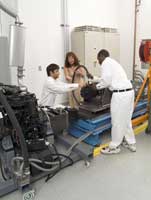Sep 10 2008
Researchers at Purdue University have shown how to reduce fuel consumption and dramatically improve the efficiency of hydraulic pumps and motors in heavy construction equipment.
 Monika Ivantysynova (center), the Purdue Maha Professor of Fluid Power Systems, works in her lab with Edat Kaya (left), a lab engineer, and Donnell Cunningham, a student from the Summer Undergraduate Research Program. Ivantysynova, director of the university's MAHA Fluid Power Research Center, has shown how to dramatically improve the efficiency of hydraulic pumps and motors in heavy construction equipment and reduce the machinery's fuel consumption. Purdue University photo - Vincent Walter
Monika Ivantysynova (center), the Purdue Maha Professor of Fluid Power Systems, works in her lab with Edat Kaya (left), a lab engineer, and Donnell Cunningham, a student from the Summer Undergraduate Research Program. Ivantysynova, director of the university's MAHA Fluid Power Research Center, has shown how to dramatically improve the efficiency of hydraulic pumps and motors in heavy construction equipment and reduce the machinery's fuel consumption. Purdue University photo - Vincent Walter
The new designs incorporate two innovations: They eliminate valves now needed to direct the flow of hydraulic fluid in heavy equipment, and they also might incorporate textured "microstructured" surfaces inside pumps to improve performance.
Research has shown the "valveless" design alone could reduce fuel consumption by 40 percent. Further savings could be realized by combining the valveless design with the advanced microstructured surface concept, said Monika Ivantysynova, Maha Fluid Power Systems Professor in Purdue's School of Mechanical Engineering.
The microstructured surfaces have been shown to dramatically reduce power losses due to friction caused by hydraulic fluid, said Ivantysynova, director of Purdue's Maha Fluid Power Research Center.
Findings were detailed in several technical papers presented by her research group earlier this summer at the Fifth Fluid Power Net International Ph.D. Symposium in Krakow, Poland.
"Currently, the best pumps and motors may have a top efficiency of 92 percent, but this efficiency level is only in a certain range of operation," Ivantysynova said. "These hydraulic pumps don't always run at this maximum level. Sometimes you only need them to provide a small amount of pressure or flow, for example, to simply hold a tool in place. Then you aren't running the pump under its highest loads, and the efficiency goes way down."
Findings have shown the microstructured surfaces reduce losses due to friction by up to 57 percent when the pump is operating at low levels and about 10 percent when operating under heavy loads. One of the research papers about the microstructured surfaces was cited as a "best paper" during the conference and was written by graduate student Jonathan Baker and Ivantysynova.
Engineers in the center are working on ways to design pumps and motors that are more efficient in their entire range of operation.
Hydraulic systems use a central "variable displacement pump" that pressurizes fluid, and valves direct the flow of fluid to "actuators," which move tools such as shovels and buckets in excavation equipment. In the new valveless design, each actuator has its own pump, eliminating the need for valves.
An excavator has been equipped with the new valveless technology in the Purdue center.
These microstructured surfaces are located in narrow gaps at several locations inside a pump that are filled with hydraulic fluid. The fluid-filled gaps, which both seal the high-pressure chamber and also work as a bearing that allows parts to move freely, are a major source of power losses.
"We are working on those gaps by using computer simulations to understand all the physical effects and to reduce efficiency losses due to friction caused by the viscosity of hydraulic fluid," she said. "We know our simulations are very close to the real physics, and we are currently working to manufacture the surfaces and will do measurements."
Conventional wisdom states that the surfaces should be polished smooth, but Ivantysynova discovered that having a surface containing features one micron high improves efficiency. The gaps are located between the pump's piston and cylinder walls and between the cylinder block and a part called the valve plate, which connects to the cylinder along with the pump ports.
Ivantysynova made the microstructured surface discovery while studying the effects of improperly machined surfaces.
"We learned that it actually improved performance to have surfaces that were not completely smooth, which was unexpected," she said.
Purdue has filed a patent for the innovation, called an "advanced gap surface design."
The innovations might be applied to a new "hydraulic hybrid" concept for cars that would use a hydraulic motor to save energy in hybrid cars.
While hydraulic pumps work by compressing a fluid, which is then used to drive tools, hydraulic motors operate in the reverse manner: high-pressure fluid is pushed into a chamber, which is used to drive a shaft and provide torque.
The hydraulic hybrids would store energy while a car is braking by compressing hydraulic fluid in a tanklike "accumulator." Then the high-pressure fluid in the accumulator would be used to drive a hydraulic motor, providing torque to the wheels and saving fuel.
In conventional electric hybrids, energy is stored by charging a battery while the car is braking.
"With batteries, however, only a portion of the braking energy can be stored because it takes much longer to charge the battery than it does to charge the accumulator with high-pressure hydraulic fluid," she said.
Engineers in the center are building a test rig of the hydraulic hybrid design, and Purdue has filed a patent on the concept.